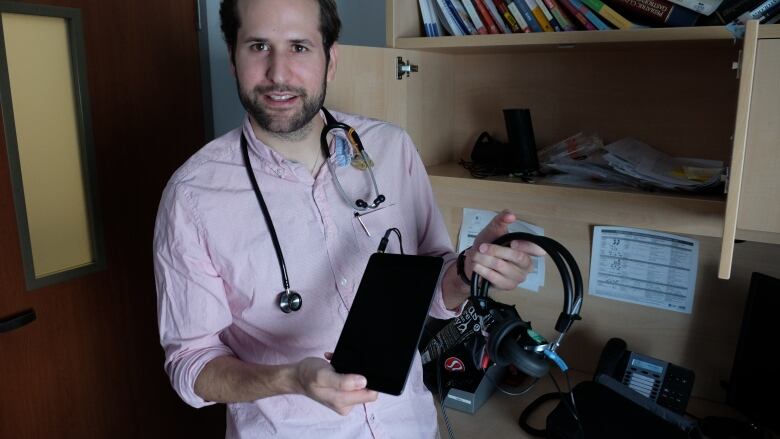Nunavut docs turn to iPad app to deal with territory's hearing loss 'crisis'
World Wide Hearing aims to help establish clinic in Iqaluit in next two months

A new, simple technology is allowing Iqaluit doctors to better diagnose ear infections and hearing loss an issue that affects children in Nunavutat a rate far higher than the rest of Canada.
Pediatrician Holden Sheffield hasbeen working at the Qikiqtani General Hospital in Iqaluit since last summer. In November, he started using an iPad outfitted with the app "ShoeBox," which was designed to test children for hearing loss.
- Nunavut gets poor grade from audiologists for lack of child hearing programs
- Canadian hearing-test app for Third World finding new uses here
Along with ShoeBox,Sheffield uses an audioscope to photograph his patients' eardrums. The photos are then sent to ear, nose and throat doctors in Ottawa, who can use the information to determine if a patient must leave the territory for surgery, or if they can be treated locally.
Sheffield is working with the World Wide Hearing Foundation, based inQuebec, to first clear a backlog on the patient waiting list. He'll then begin working toestablish a hearing clinic at the Iqaluit hospital likely within the next two months.
The idea behind the clinic is to focus on patients who have had multiple ear infections, which Sheffield says is a problem he sees often.
'A national health crisis'
World Wide Hearing works to treat hearing loss in underdeveloped countries around the world, but have recently focused on Nunavut, where the territory's youth have a high occurrence of hearing loss.
Audra Renyi, the foundation's executive director, hasbeen working in the territory for a year-and-a-halfto try and address what she says is a"national health crisis," through bringing technology to local doctors like Sheffield and working to create clinics.
Sheffield saysthe high rate of hearing loss is due to re-occurring infections, which he hopes the clinic will help address.
"It's not necessarily that they're untreated," he said, "but in general, they just get so many of them."
The reason for the high rate of re-occurring infections is "a complicated question," he said. "It's probably related to lots of issues from crowded houses to smoke exposure, in certain situations if there's poor hand hygiene...these are all things that could lead to increased rates of ear infections."
Doctors like Sheffield could soon see an indirect boost to their efforts at fighting infection. Last month, World Wide Hearing won $750,000 from GoogleCanada, which it will use to develop a cloud-based platform, named Teleaudiology, which will allow for doctors to more easily diagnose patients in remote communities.
In the meantime, World Wide Hearingwill continue to work to develop capacity at the community level educating local communities about preventing infection, as well as working with doctors like Sheffield to provide basic diagnoses, so infections can be treated early.
That's good news to Sheffield, who says issues with hearing loss can have negative impacts throughout development.
"Kids who have difficulty with hearing are going to have difficulty with our speech, difficulty developing appropriately," he said."Because we need our hearing in order to be able to develop, as infants, and as we grow."












_(720p).jpg)


 OFFICIAL HD MUSIC VIDEO.jpg)
.jpg)



























































































